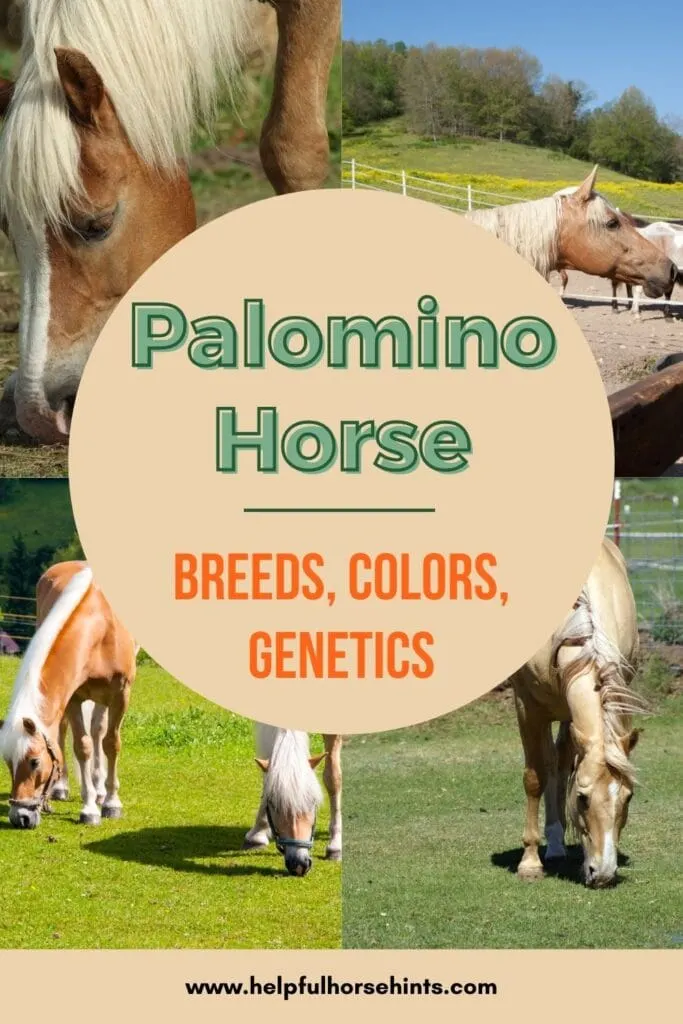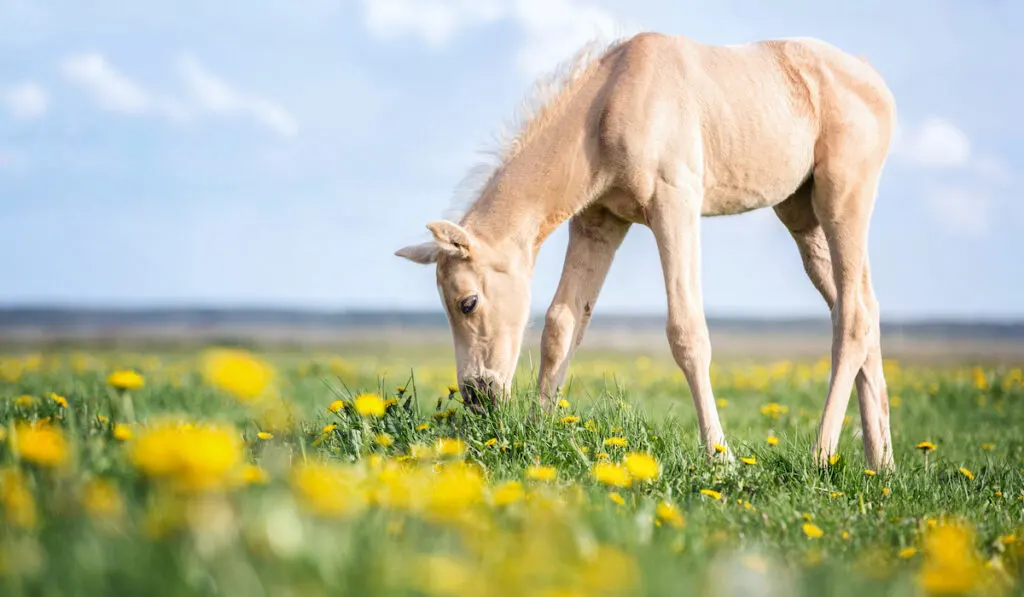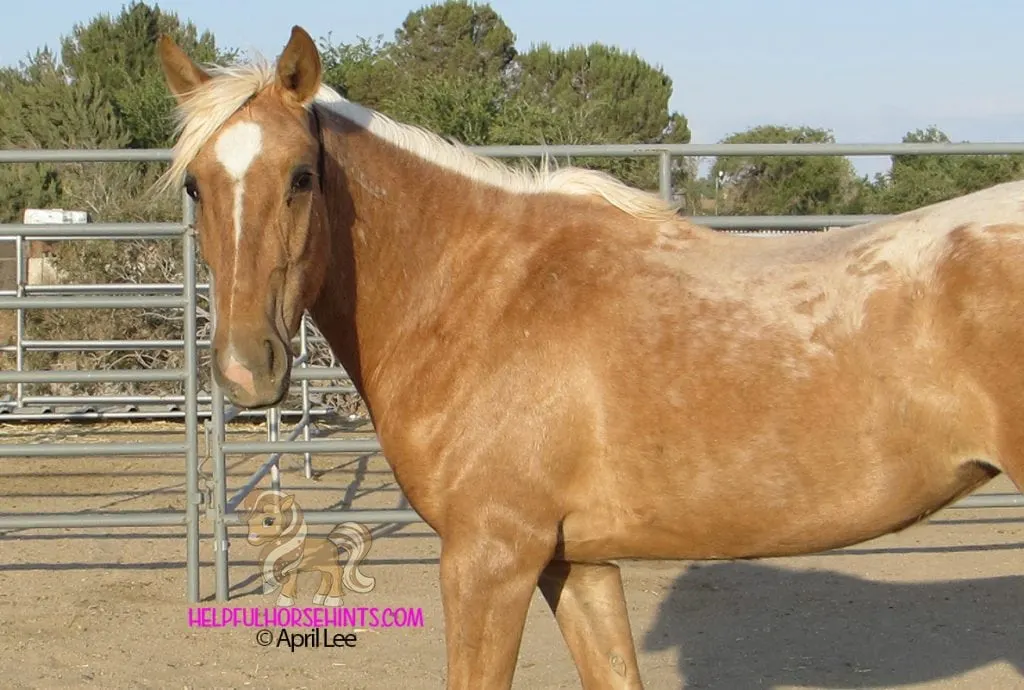The palomino horse is a beauty to behold. The snow-white mane and tail contrast to a beautiful golden body. This color was made most famous by Roy Rogers who chose a Palomino horse, Trigger, for his movie series. Today, the palomino horse remains very popular. There are many different breeds of horses that can be palomino. The color varies as well, ranging from a very light, almost white, coat to a very deep chocolate color. I know you are dying for details so let’s explore the Palomino Horse!
Table of Contents
Palomino coat color genetics
All true palomino horses have a chestnut base coat with one copy of the creme gene (nCr). Of course, there could be other modifiers as well like a paint gene for palomino pintos or a LP gene for a palomino appaloosa. Regardless the base color will be chestnut (ee) and one cream (nCr).
Some horses that look Palomino actually are not genetically palomino. A horse can be a flaxen chestnut, which is a really dark red with a white mane and tail. They can also be champagne or pearl which are caused by different dilutions, not the cream gene.
If you want to find out whether or not your horse is a true palomino, you can have him tested for the cream gene at any of the major equine DNA testing labs. Check out our article on horse DNA testing for more details on how that works!
How to Guarantee A Palomino Foal
When breeding horses, always remember that color should be a very small consideration. Confirmation, quality and temperament should be considered first and foremost.

Both horses should be free from genetic diseases that could be passed on to the baby. Both horses should be old enough and in good physical condition before being considered to breed.
Even with all that, it is usually cheaper to just find and buy a horse that is the right color, right size and right confirmation vs. trying to breed a foal.
If you still want to breed your mare or stallion, how do you guarantee you will get a palomino foal? There is only one combination that results in a palomino foal 100% of the time.
If you want to guarantee a palomino foal, one parent must be a cremello, and one parent must be chestnut. This combination will result in a palomino foal 100% of the time.
If your horse isn’t cremello or chestnut, what are your chances of getting a palomino baby? The result is entirely dependent on your horse’s actual color genetic makeup.
Once you know that, you can figure out the right color horse to breed to. Once you know your horse’s color, you can use this coat color calculator at the Animal Genetics website to try different combinations.
Palomino Horse Characteristics
Palomino horses are easy to spot due to their gorgeous gold color and contrasting white mane and tail. Some shades, though, maybe misidentified at first. Some are so light they look almost white.
Some palomino horses are so dark the color can be compared to chocolate. The section below shows some great examples of different shades of the palomino color.
What about physical type? The physical type of a palomino can vary wildly because a palomino is a color not a breed. A palomino Quarter Horse is going to look way different than a Palomino American Saddlebred. In addition, there are many types of cross-bred horses and ponies that can be palomino.
Shades of Palomino in horses – The White-Maned Golden Horse
Palomino horses come in so many different shades! The palomino is a horse with a white mane and tail. They are well known for being the white-maned golden horse but even gold has different shades! Some common shades of palomino are:
- Light Palomino
- Golden Palomino
- Champagne Palomino
- Pearl
- Chocolate Palomino
Let’s look at some of these colors in more detail!
Light Palomino Horse
Most palominos are born with a very light-colored foal coat like this cutie below. Foals that are going to grow up to be really dark, like a chocolate palomino, can be born darker though.
Usually, palomino foals will have blue or light-colored eyes that will change color as they grow.

While we usually think of palominos as a horse with a deep gold coat and white mane and tail, some palominos never get that dark gold color. Instead, they stay a light cream color.
When choosing a palomino horse name for a light-colored horse you might want to consider names that make you think of things that are light and airy like maybe Buttercream.

Golden Palominos
The golden palomino is the color most people think of when someone mentions a palomino.The dark yellow coat provides an awesome contrast to the stark white mane. Golden palominos usually get lighter during winter when their long winter coat grows in.
This palomino mustang gelding below is almost done shedding his winter coat so you can see the contrast between winter and summer coat more easily.

Chocolate Palomino
On the very darkest end of the spectrum is the chocolate palomino. These horses can be so dark they look brown which is where they get their name.
Normally though, they just have a more sooty appearance like they rolled in ashes or some liquid milk chocolate! They still have the hallmark white mane but sometimes their mane and tail will have black hairs mixed in as well.

Palomino Champagne Horses & Other Rare Palominos
Genetically speaking, a palomino champagne like the one below isn’t a true palomino. This horse is actually a chestnut with a champagne gene. The champagne gene dilutes the red color to make the horse look like a palomino. It is also what causes that awesome shine!
This horse (pictured below) is a foundation quarter horse I once owned. During the winter, he’d get super light just like the light palomino above.

The Pearl gene behaves similarly to the champagne gene. It dilutes a red horse to a light, super shiny cream color with blue eyes. Pearl horses are common in the Andalusian and Lusitano breeds but occur in other breeds as well.
Palomino Horse Breeds
The palomino horse is a color, not a breed. In fact, not all breeds have Palomino horses. For some horse breeds, diluted horse colors like Palomino and Buckskin were either initially excluded or eliminated over time. That means that if you want a purebred palomino, you’ll have to make sure to look in breeds that have them. These include:
- Quarter Horse
- Paint Horse
- Lusitano Horse (check out our article)
- Appaloosa Horse
- Tennessee Walker
- Morgan
- Fox Trotter
- Thoroughbred
- Kentucky Mountain Saddle Horse
Breeds of Horses that Don’t Have Palominos
- Andalusian
- Lipizzan
- Arabian (flaxen chestnuts can appear palomino but the creme gene does not exist in the breed. A famous example of this is the horse Fire and Ice)
I think the fact that palomino horses come in so many different breeds and color shades are part of what makes them awesome. My mare, Malibu, is a palomino paint mustang. If you are in the market for a horse, definitely consider purchasing a palomino!
RELATED POSTS
Source:
- https://www.animalgenetics.us/equine/coat_color/Cream.asp
- https://www.animalgenetics.us/Equine/CCalculator1.asp

